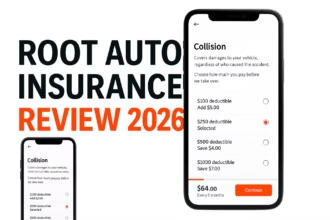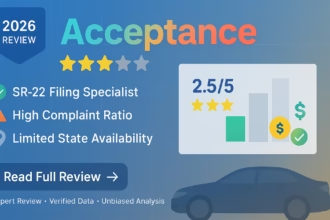
Many Americans assume they can’t get car insurance without a valid driver’s license, but that’s not true. In fact, over 11 million Americans drive without a license, and many more need coverage for stored vehicles, teen drivers with permits, or family members who can no longer drive. The challenge isn’t getting coverage, it’s finding cheap car insurance with no license that doesn’t break your budget.
The Problem: Why Car Insurance Without a License Costs More
Insurance companies view unlicensed drivers as higher risk because they can’t assess your driving record. Without traffic violations, accident history, or license points to review, insurers often charge premium rates that can be 20-50% higher than standard coverage. Add in the complexity of applying (most online quote systems require a license number), and many people end up paying far more than necessary.
But here’s the good news: With the right approach, you can secure affordable coverage even without a license.
Compare Cheap Car Insurance Rates Now →
What Affects Car Insurance Rates for Unlicensed Drivers
Understanding how insurers price no-license policies helps you find the cheapest options:
Risk Assessment Factors
- License status (suspended, revoked, never had one, or learner’s permit)
- Reason for no license (DUI suspension costs more than age-related non-driving)
- Vehicle usage (stored car vs. daily family use)
- Primary driver’s record (if naming someone else as main driver)
Coverage Type Impact
- Full coverage with comprehensive and collision
- Liability-only for minimum state requirements
- Non-owner insurance for occasional driving
- SR-22 filing requirements for suspended licenses
Geographic Factors
Insurance costs vary significantly by state. For example:
- California requires proof of insurance for vehicle registration, even for non-drivers
- Florida and Virginia require FR-44 certificates (higher limits than SR-22)
- No-fault states like Michigan and New York have higher minimum requirements
How to Get Cheap Car Insurance With No License: 5 Proven Strategies
1. Choose the Right Coverage Type for Your Situation
Non-Owner Insurance (Cheapest Option) If you don’t own a vehicle but occasionally drive borrowed or rental cars, non-owner insurance provides liability coverage at a fraction of full coverage costs. Average annual costs:
- Clean record: $400-$600
- With violations: $800-$1,200
- With DUI: $1,500-$2,500
Parked Car Insurance For stored or rarely driven vehicles, comprehensive-only coverage protects against theft, vandalism, and weather damage without collision or liability costs:
- Average annual cost: $200-$400
- Perfect for classic cars, seasonal vehicles, or long-term storage
2. Name a Licensed Primary Driver
The most common way to get affordable coverage is listing a licensed family member or friend as the primary driver while excluding yourself from the policy. This approach offers:
- Access to their driving record and discounts
- Standard rates instead of high-risk pricing
- Full coverage options for your vehicle
Important: You must exclude yourself from coverage, meaning you won’t be protected if you drive the vehicle.
3. Target Specialist Insurers
While major carriers often decline no-license applications, specialist insurers focus on non-standard drivers:
Best Specialist Options:
- The General: Accepts drivers with coverage gaps and poor credit
- Acceptance Insurance: Specializes in all types of high-risk situations
- Direct Auto: Expert in SR-22 filings and suspended license coverage
- Bristol West: Handles first-time drivers and no insurance history
4. Optimize Your Payment Strategy
Annual vs. Monthly Payments Paying annually eliminates installment fees and qualifies for upfront payment discounts:
- Monthly payments: Add $5-$15 per month in fees
- Annual payment discount: 5-10% off total premium
- Total savings: $100-$300 annually
Electronic Payment Discounts
- Auto-pay: 2-5% discount
- Paperless billing: $5-$25 annual savings
- Bank draft vs. credit card: Lower processing fees
Find Your Cheapest Rate Today →
Best Cheap Car Insurance Without License Providers
| Provider | Best For | Average Annual Cost | Key Benefits |
| State Farm | Teen drivers with permits | $2,167 (standard rate) | Local agents, family discounts |
| Progressive | DUI suspensions | $2,770 (with DUI) | Nationwide coverage, Snapshot discounts |
| USAA | Military families | $1,407 (standard rate) | Lowest rates, military-specific benefits |
| The General | Coverage gaps | $1,800-$2,500 | Accepts difficult cases |
| Acceptance Insurance | High-risk drivers | $2,000-$3,000 | Neighborhood agents, flexible terms |
Note: Rates vary by state, coverage level, and individual circumstances
Money-Saving Tips for No-License Car Insurance
Maximize Available Discounts
Even without a license, you can access numerous discounts:
Vehicle-Based Discounts:
- Anti-theft devices: 5-10% discount
- Safety features (airbags, ABS): 5-15% discount
- Low annual mileage: 10-25% discount
- Garage parking: 5-10% discount
Policy Discounts:
- Multi-policy bundling: 10-20% discount
- Good student (for teen drivers): 10-15% discount
- Defensive driving course: 5-10% discount
- Loyalty discounts: 5-10% after 3+ years
Improve Your Credit Score
Insurance companies in most states use credit scores to determine rates. Improving your credit can reduce premiums by 10-30%:
- Pay bills on time consistently
- Keep credit utilization below 30%
- Check credit reports for errors
- Consider credit repair if needed
Choose Higher Deductibles
Increasing your deductible from $500 to $1,000 can reduce premiums by 10-20%. For comprehensive-only coverage, this strategy works particularly well since you’re mainly protecting against theft or vandalism.
Common Mistakes to Avoid When Shopping for No-License Insurance
1. Trying to Apply Online
Most online quote systems require license numbers and will reject applications. Always call insurers directly or work with independent agents who can access multiple companies.
2. Hiding Your License Status
Being dishonest about your license status will void your policy and leave you completely unprotected. Always disclose your situation upfront.
3. Accepting the First Quote
Rates vary dramatically between insurers for no-license coverage. Get quotes from at least 3-5 companies, focusing on both standard and specialist insurers.
4. Choosing Minimum Coverage Only
While liability-only coverage costs less, it won’t protect your vehicle. Consider comprehensive coverage for theft and vandalism protection, especially for valuable cars.
5. Letting Coverage Lapse
Insurance gaps result in higher rates when you resume coverage. Maintain continuous coverage, even if you switch to non-owner insurance during non-driving periods.
Special Situations: Getting Cheap Coverage by Scenario
Suspended License (SR-22 Required)
If your license is suspended, you’ll need SR-22 or FR-44 filing:
- SR-22 filing fee: $15-$50
- Premium increase: 20-50% above standard rates
- Cheapest SR-22 providers: GEICO, Progressive, State Farm
Non-Owner SR-22 Option: If you don’t own a car but need proof of insurance for license reinstatement, non-owner SR-22 policies cost $400-$800 annually.
Teen Drivers with Permits
Adding a teen with a learner’s permit to a parent’s policy costs less than separate coverage:
- Cost to add teen: $1,000-$2,000 annually
- Standalone teen policy: $3,000-$6,000 annually
- Best providers: State Farm, USAA (military families), Progressive
International Drivers
Foreign visitors can get coverage with home country licenses:
- Valid for: 3 months (foreign license) or 1 year (International Driving Permit)
- Classification: “New driver” rates apply
- Average cost: 20-40% higher than experienced drivers
Elderly Non-Drivers
Seniors who no longer drive but own vehicles for caregivers:
- Best approach: Name caregiver as primary driver
- Coverage needed: Full coverage including liability
- Potential savings: Senior discounts may still apply
Get Your Personalized Quote Now →
State-Specific Requirements and Costs
High-Cost States
- Michigan: No-fault coverage required, highest rates nationally
- Louisiana: High uninsured driver rates increase premiums
- Florida: FR-44 required for serious violations
Low-Cost States
- Maine: Lower population density, fewer claims
- Idaho: Rural state with lower accident rates
- Iowa: Competitive insurance market
Special Requirements
- California: Proof of insurance required for vehicle registration
- New Hampshire: No insurance requirement, but financial responsibility laws apply
- Virginia: Option to pay uninsured motorist fee instead of buying insurance
Building Your Strategy: Step-by-Step Action Plan
Step 1: Assess Your Situation
- Why do you need insurance without a license?
- Will you eventually get a license?
- Do you own a vehicle or just need coverage for driving?
Step 2: Choose Your Approach
- Own a car: Name licensed primary driver or get parked car insurance
- Don’t own a car: Consider non-owner insurance
- Suspended license: Research SR-22 requirements
Step 3: Research Providers
- Contact 3-5 insurers directly
- Include both standard and specialist companies
- Ask about discounts and payment options
Step 4: Compare Total Costs
- Include filing fees for SR-22/FR-44
- Factor in payment plan fees
- Calculate annual vs. monthly costs
Step 5: Maintain Coverage
- Set up automatic payments
- Keep coverage active even if not driving
- Review annually for better rates
Trust Builders: Expert Insights and Industry Data
According to the Insurance Information Institute, approximately 13% of drivers nationwide are uninsured, making licensed drivers with coverage increasingly valuable to insurers. This trend actually benefits unlicensed drivers who can demonstrate financial responsibility through continuous coverage.
Industry Expert Tip: “The key to affordable no-license coverage is building a relationship with an independent agent who understands your specific situation,” says Sarah Martinez, licensed insurance agent with 15 years of experience. “They can access multiple carriers and find coverage that online systems would reject.”
Statistical Insight: A 2024 study by the National Association of Insurance Commissioners found that drivers who maintain continuous coverage—even during non-driving periods—pay 23% less when they resume driving compared to those with coverage gaps.
The Bottom Line: Your Path to Affordable Coverage
Getting cheap car insurance with no license requires strategy, but it’s absolutely achievable. Whether you need coverage for a suspended license, teen driver, stored vehicle, or family member, the right approach can save you hundreds of dollars annually.
Key Takeaways:
- Non-owner insurance offers the cheapest liability coverage
- Naming a licensed primary driver provides access to standard rates
- Specialist insurers often beat major carriers for no-license coverage
- Payment strategy and discounts can reduce costs by 20-30%
- Continuous coverage prevents expensive gaps in your insurance history
Remember: Insurance rates change frequently, and what’s cheapest today might not be tomorrow. The companies offering the best rates for your specific situation depend on your location, coverage needs, and personal circumstances.
Don’t let lack of a license keep you from protecting your assets or meeting legal requirements. With the right coverage and strategy, you can secure affordable protection and peace of mind.
Compare Your Options and Save Today →
In another related article, How to Save on Car Insurance in 2025 (Even If You’re a New Driver)





